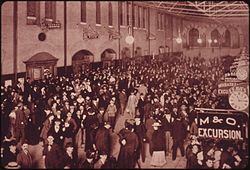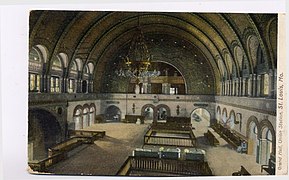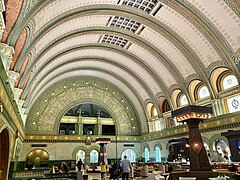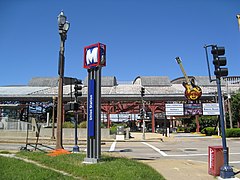St. Louis Union Station is a National Historic Landmark and former train station in St. Louis, Missouri, United States. At its 1894 opening, the station was the largest in the world. Traffic peaked at 100,000 people a day in the 1940s. The last Amtrak passenger train left the station in 1978.
In the 1980s, it was renovated as a hotel, shopping center, and entertainment complex. The 2010s and 2020s saw more renovation and expansion of entertainment and office capacity. The current hotel portion of the station is currently a member of Historic Hotels of America, the official program of the National Trust for Historic Preservation.
An adjacent station serves the light-rail MetroLink Red and Blue Lines, which run under the station in the Union Station subway tunnel. The city's intercity train station sits 1⁄4 mile (400 m) to the south, serving MetroLink, Amtrak, and Greyhound Bus.
History
19th century



The station was opened on September 1, 1894, by the Terminal Railroad Association of St. Louis. The station was designed by Theodore Link, and included three main areas: the Headhouse and the Midway, and the 11.5-acre (47,000 m) Train Shed designed by civil engineer George H. Pegram. The headhouse originally housed a hotel, a restaurant, passenger waiting rooms and railroad ticketing offices. It featured a gold-leafed Grand Hall, Romanesque arches, a 65-foot (20 m) barrel-vaulted ceiling and stained-glass windows. The clock tower is 230 feet (70 m) high.
Union Station's headhouse and midway are constructed of Indiana limestone and initially included 32 tracks under its vast trainshed terminating in the stub-end terminal. Its Grand Hall, which cost around $6.5 million and was about 75 by 125 feet (23 by 38 m) large, was considered to be one of the most beautiful public lobbies.
At its opening, it was the world's largest and busiest railroad station and its trainshed was the largest roof span in the world.
20th century
In 1903, Union Station was expanded to accommodate visitors to the 1904 St. Louis World's Fair. In the 1920s, it remained the largest American railroad terminal.
At its height, the station combined the St. Louis passenger services of 22 railroads, the most of any single terminal in the world. In the 1940s, it handled 100,000 passengers a day. During World War II, German actor Til Kiwe, was recaptured in the station's waiting room after escaping from a POW camp in Colorado.
The 1940s expansion added a new ticket counter designed as a half-circle and a mural by Louis Grell could be found atop the customer waiting area which depicted the history of St. Louis with an old fashion steam engine, two large steamboats and the Eads Bridge in the background. The famous photograph of Harry S. Truman holding aloft the erroneous Chicago Tribune headline, "Dewey Defeats Truman", was shot at the station as Truman headed back to Washington, D.C., from Independence, Missouri, after the 1948 Presidential election.
As airliners became the primary mode of long-distance travel and railroad passenger services declined in the 1950s and 1960s, the massive station became obsolete and too expensive to maintain for its original purpose. By 1961, several tracks had been paved over for parking. Amtrak took over passenger service in 1971 but abandoned Union Station on October 31, 1978. By then, Amtrak had cut back service to four routes per day–the State House, the Ann Rutledge, the National Limited (formerly the Spirit of St. Louis) and the Inter-American. The eight total trains were nowhere near enough to justify the use of such a large facility. The last train to leave Union Station was a Chicago-bound Inter-American. Passenger service shifted to a temporary-style "Amshack" two blocks east. Amtrak has since moved its St. Louis service to the Gateway Transportation Center, one block east of Union Station.
The station was designated a National Historic Landmark in 1970, as an important surviving example of large-scale railroad architecture from the late 19th century. It was designated as a National Historic Civil Engineering Landmark by the American Society of Civil Engineers in 1981.
In August 1985, after a $150 million renovation designed by HOK, Union Station was reopened with a 539-room hotel, shopping mall, restaurants and food court. Federal historic rehabilitation tax credits were used to transform Union Station into one of the city's most visited attractions. The station rehabilitation by Conrad Schmitt Studios remains one of the largest adaptive re-use projects in the United States. The hotel is housed in the headhouse and part of the train shed, which also houses a lake and shopping, entertainment and dining establishments. Omni Hotels was the original hotel operator, followed by Hyatt Regency Hotel chain and Marriott Hotels.
21st century


In 2010–11, the station's Marriott Hotel in the main terminal building was expanded. It took over the station's Midway area; all stores were moved to the train shed shopping arcade. In 2012, Lodging Hospitality Management bought Union Station and rebranded the hotel as a DoubleTree. In August 2016, Lodging Hospitality Management announced plans to renovate Union Station once again, included plans for an aquarium. The Memories Museum features artifacts and displays about the history of St. Louis Union Station and rail travel in the United States. Located on the upper level of the train shed, the museum is a joint project of Union Station Associates and the National Museum of Transportation. The original architectural drawings and blueprints for Union Station and the original hotel are available to researchers at the Washington University Archives at Washington University in St. Louis. Some architectural elements from the building have been removed in renovations and taken to the Sauget, Illinois, storage site of the National Building Arts Center.
St. Louis Union Station was the venue for the FIRST Tech Challenge World Championship component of the FIRST Championship, hosted in St. Louis every April until 2017, after which it was moved to Detroit.
The station's train shed area features The St. Louis Wheel, a 200 ft (61 m) high, 42 gondola observation wheel.
Inside the station is The St. Louis Rope Course, a 90,000 cubic feet (2,500 m), 3-story indoor ropes and zip line course.
Union Station has two light show features: one in the train shed area, and another inside Union Station Hotel's lobby.
In January 2020, Build-A-Bear Workshop, Inc. moved their global headquarters to downtown St. Louis inside the 68,000 ft (21,000 m) Grand Central Building inside the Union Station complex. The company also opened their new Build-A-Bear Workshop Union Station headquarters store and also operates a Build-A-Bear Radio studio and other experiential elements at their new headquarters. Additionally, a Ferris wheel, aquarium, and an abundance of restaurants have been added to Union Station in 2020.
In 2020, the St. Louis Aquarium opened in the former shopping mall space in the building. At 120,000 sq ft (11,000 m), the aquarium is home to more than 13,000 animals representing over 250 species.
Transportation
MetroLink
Main article: Union Station (MetroLink)MetroLink, the St. Louis region's light rail system, serves Union Station via the Red and Blue lines. The station is located beneath the train shed in the historic Union Station Baggage Tunnel. This tunnel was originally constructed in the 1890s as a below grade transfer area for baggage between trains. It was converted and opened for MetroLink usage in 1993 and has seen several renovations over the years, most notably in 2010 and 2016. The tunnel is expected to see another major renovation in 2024.
It takes about 30 minutes to travel to either terminal at St. Louis Lambert International Airport via the Red Line.
Gateway Transportation Station
The city's major transportation hub, Gateway Multimodal Transportation Center, is located two blocks from Union Station. It also serves MetroLink in addition to local buses and national connections with Amtrak, Greyhound and other services.
Taxi and rideshare
St. Louis Union Station has 24-hour taxi service at its north entrance on Market Street.
Filming
In 1981, areas of the then disused station were used in the filming of John Carpenter's movie Escape from New York. A scene involving the captured President was shot in the station's train shed and the film's gladiatorial fight was staged in the Grand Hall.
Gallery
-
 Union Station postcard from about 1909
Union Station postcard from about 1909
-
 Grand Hall, postmarked 1909
Grand Hall, postmarked 1909
-
 Grand Hall in 2023
Grand Hall in 2023
-
 George Washington leaving St. Louis Union Station, 1967
George Washington leaving St. Louis Union Station, 1967
-
 MetroLink monument sign at Union Station
MetroLink monument sign at Union Station
See also
References
- "National Register Information System". National Register of Historic Places. National Park Service. March 13, 2009.
- "Union Station". National Historic Landmark summary listing. National Park Service. Archived from the original on March 1, 2009. Retrieved June 28, 2008.
- ^ Holmes, M. Patricia (January 28, 1970). "National Register of Historic Places Nomination Form: St. Louis Union Station" (PDF). Missouri Department of Natural Resources. Archived from the original (PDF) on October 30, 2020. Retrieved February 23, 2020.
- "Hotel History – St. Louis Union Station, Curio Collection by Hilton". Historic Hotels of America. Retrieved December 14, 2022.
- "About – St. Louis Union Station". St. Louis Union Station. Retrieved May 11, 2016.
- "Archived copy" (PDF). Archived from the original (PDF) on October 30, 2020. Retrieved February 24, 2020.
{{cite web}}: CS1 maint: archived copy as title (link) - "Elegant detail inside the former St. Louis Union Station, which, at its opening in 1894, was the world's largest train station". Library of Congress. Retrieved July 29, 2024."Union Station Historic District". State of Missouri. Retrieved July 29, 2024."Union Station". ASCE (American Society of Civil Engineers). Retrieved July 29, 2024.
- ^ "Historic Station At End Of Line". Toledo Blade. November 1, 1978. Retrieved April 25, 2010. The source says there were three daily trains when there were actually four.
- "Union Station, 1820 Market Street, St. Louis, Missouri / The National Survey of Historic Sites and Buildings / DEPARTMENT OF THE INTERIOR NATIONAL PARK SERVICE". nps.gov. January 8, 1971. Retrieved October 10, 2017.
- "For Nazi Officers, Trinidad's POW Camp Was the Great Escape". www.westword.com. November 21, 2017.
Still, the obstacles didn't deter Captain Till Edward Kiefer, who was shot down over Tunisia in 1943 and escaped his American captors three times. For his most notable egress from the Trinidad camp, he used a vegetable dye to turn his dress uniform brown and arranged for a noncom to answer for him at roll call. He made it to St. Louis before someone noticed that there was an Aryan-looking fellow in full Nazi attire killing time in the train station waiting room.
- "Save the Amshack!". Riverfront Times. December 4, 2008. Archived from the original on August 11, 2015. Retrieved December 28, 2008.
- "NHL nomination for Union Station" (PDF). Missouri DNR. Archived from the original (PDF) on January 25, 2017. Retrieved March 7, 2017.
- "Union Station Historical Marker". The Historical Marker Database. Retrieved March 6, 2021.
- Artisans here put skills to work restoring St. Louis train station – The Milwaukee Sentinel – Aug 29, 1985
- Trains could return to St. Louis Union Station
- "St. Louis Union Station – A National Historic Landmark with Memories As Major Rail Hub". St. Louis Front Page. Archived from the original on October 7, 2015. Retrieved November 16, 2015.
- "St. Louis Union Station Architectural Drawings (WUA00363), 1891–1970 | WUA University Archives". archon.wustl.edu. Archived from the original on October 10, 2017. Retrieved June 15, 2017.
- List of Recovered Buildings Archived November 17, 2009, at the Wayback Machine
- "New glory for Union Station: Alumnus Steve O'Loughlin helps transform the once-dead mall and sees it through the pandemic". January 4, 2021.
- Lyles-Wiggins, Francoise (August 8, 2018). "Union Station Tunnel" (PDF). Bi-State Development Agency. Retrieved August 8, 2023.
- Courtney (December 14, 2010). "Union Station Tunnels Get An Upgrade in Infrastructure". Metro Transit – Saint Louis. Archived from the original on August 10, 2023. Retrieved August 8, 2023.
- "Modjeski and Masters awarded engineering contract for St. Louis Union Station Tunnel". Railway Track and Structures. December 7, 2016. Retrieved August 8, 2023.
- "MetroLink Improvement Projects". Metro Transit – Saint Louis. Retrieved August 8, 2023.
- "Filming Locations for Escape From New York (1981), in Missouri, Los Angeles and New York". The Worldwide Guide to Movie Locations. Retrieved August 8, 2023.
Further reading
- Montesi, Albert and Richard Deposki (2002). St. Louis Union Station. Arcadia Publishing. ISBN 0-7385-1983-9.
- "National Register of Historic Places: Inventory – Nomination Form" (PDF). Missouri Department of Natural Resources. Archived from the original (PDF) on October 30, 2008. Retrieved May 30, 2008.
- The St. Louis Union Station: a monograph by the architect and officers of the Terminal Railroad Association of St. Louis.
- "St. Louis Union Station". www.achp.gov. Advisory Council on Historic Preservation.
External links
Portals:| Amtrak stations in Missouri | |
|---|---|
| Active stations | |
| Former stations |
|
| Future stations |
|
| U.S. National Register of Historic Places | |
|---|---|
| Topics | |
| Lists by state |
|
| Lists by insular areas | |
| Lists by associated state | |
| Other areas | |
| Related | |
| Shopping malls in Missouri | |
|---|---|
| St. Louis | |
| Kansas City | |
| Elsewhere | |
| Defunct | |
| Museums and cultural institutions in Greater St. Louis | |
|---|---|
| Art | |
| Architecture | |
| Botanical | |
| Children's | |
| History |
|
| Science and natural history | |
| Sports | |
| Theatres and music venues | |
| Transportation | |
| Zoological | |
| Timeline of the tallest buildings in Missouri | |
|---|---|
|
| Timeline of the tallest buildings in St. Louis | |
|---|---|
|
| |
| Public transportation in Greater St. Louis | |
|---|---|
| Public transit agencies | |
| Local and express bus service |
|
| Demand response |
|
| Light rail | |
| Streetcar | |
| Infrastructure | |
| Intercity rail | |
| Intercity bus | |
| Airports | |
| Other | |
| Italics denote lines or service which are planned or not operating | |
- Transportation buildings and structures in St. Louis
- Former Chicago and Eastern Illinois Railroad stations
- Clock towers in Missouri
- Former Amtrak stations in Missouri
- Former railway stations in Missouri
- Historic American Engineering Record in Missouri
- Historic Civil Engineering Landmarks
- History of St. Louis
- Landmarks of St. Louis
- Former Missouri–Kansas–Texas Railroad stations
- Museums in St. Louis
- National Historic Landmarks in Missouri
- Rail in St. Louis
- Railway hotels in the United States
- Railway stations on the National Register of Historic Places in Missouri
- Railway stations in the United States opened in 1894
- Romanesque Revival architecture in Missouri
- Shopping districts and streets in the United States
- Former Baltimore and Ohio Railroad stations
- Former Mobile and Ohio Railroad stations
- Former Chicago and Alton Railroad stations
- Former Illinois Central Railroad stations
- Former Chicago, Rock Island and Pacific Railroad stations
- Former New York Central Railroad stations
- Former Pennsylvania Railroad stations
- Former Missouri Pacific Railroad stations
- Former Southern Railway (U.S.) stations
- Former Louisville and Nashville Railroad stations
- Former New York, Chicago and St. Louis Railroad stations
- Former Chicago, Burlington and Quincy Railroad stations
- Former St. Louis Southwestern Railway stations
- Towers in Missouri
- Union stations in the United States
- Tourist attractions in St. Louis
- Railroad-related National Historic Landmarks
- Railroad museums in Missouri
- National Register of Historic Places in St. Louis
- Art Nouveau architecture in Missouri
- Art Nouveau railway stations
- Downtown West, St. Louis
- Former St. Louis–San Francisco Railway stations
- Former Wabash Railroad stations
- 1894 establishments in Missouri
- Shopping malls in Missouri
- Railway stations in the United States closed in 1978
